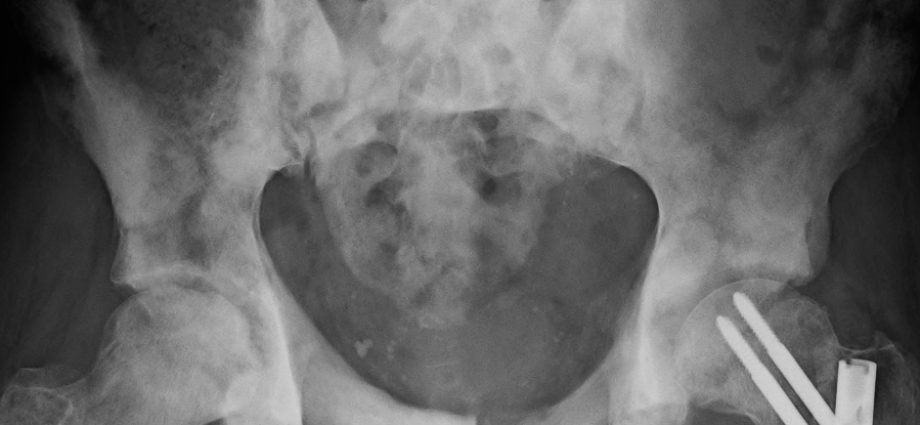Contents
Osteosclerosis
Osteosclerosis is an increase, localized or diffuse, in bone density. Diagnosis is usually based on symptoms and a set of x-ray examinations. The most common symptoms are bone fragility, morphological and blood abnormalities. There is no treatment for osteosclerosis, which is generally irreversible, but diet and regular physical activity can prevent its onset and development.
Osteosclerosis, what is it?
Definition
Osteosclerosis is characterized by thickening of the trabecular bone resulting in increased bone density. Also called cancellous bone, trabecular bone is the central part of the bones. It consists of spans in the form of plates or columns connected to each other and surrounded by tissue composed of fats and stem cells, and highly vascularized. The spongy bone represents only 20% of the adult skeleton, it mainly makes up the small bones (vertebrae).
Types
There are two types of osteosclerosis:
- Localized, at the level of a small portion of the skeleton;
- Diffuse, when it affects a large area of the skeleton (eg the entire spine).
Causes
Bone lesions
Osteosclerosis can occur as a reaction to bone damage such as a bone fracture, bone inflammation, bone cancer, or osteoarthritis.
Osteopetrosis
Osteopetrosis is the most well-known form of osteoclerosis. Osteopetrosis is a rare hereditary disease mainly due to dysfunction of osteoclasts, the cells in charge of destroying old bone. As the body does not recycle old bone cells, it leads to increased bone density and altered bone shape. There are different forms of osteopetrosis which vary in course from death in utero to the form remaining completely asymptomatic.
Bone dysplasias
Osteosclerosis can occur during bone dysplasia, a developmental disorder of the bone resulting in an abnormality in shape, volume or function. Bone dysplasia can affect the bones of the skull, face, long bones of the body, or the entire skeleton.
Osteosclerosis can also manifest itself in the context of broader pathologies also involving bone dysplasia, in particular hyperostosis (Caffey’s disease, melorheositis), Worth’s syndrome, hyperostotic Lenz-Majewski dwarfism, Pyle’s disease, Engelmann’s disease or pycnodysostosis, a pathology characterized by osteosclerosis of the skeleton, short stature and bone fragility.
Metabolic diseases
Osteosclerosis can also manifest itself in certain metabolic diseases such as:
- Poisoning with lead, arsenic, beryllium or bismuth;
- An excessive amount of vitamin A and D;
- Osteosclerosis associated with hepatitis C virus;
- Fluorosis, a pathology linked to an excess of fluorides;
- Pseudohypoparathyroidism, a group of very rare diseases characterized by a defect in the expression of parathyroid hormone, a hormone that regulates the level of calcium in the blood;
- Osteomalacia, a generalized osteopathy in adults, mainly linked to vitamin D deficiency and characterized by a defect in bone mineralization;
- Kidney failure;
- Rickets, diseases characterized by insufficient calcification of bones and cartilages and due to vitamin D and calcium deficiency.
Other causes
Osteosclerosis can manifest itself in other cases:
- Ionizing radiation or intravenous drug poisoning;
- Lymphomas
- Leukemias;
- Sarcoidosis, a systemic inflammatory disease of unknown cause;
- Paget’s disease, a benign, localized bone disease characterized by accelerated bone turnover;
- Certain cancers of the blood (Vaquez’s disease) or of the spinal cord (myelofibrosis);
- Anemias;
- Osteomyelitis, an infection of the bone most often caused by bacteria;
Diagnostic
The diagnosis is usually based on symptoms and a set of x-ray examinations:
- Conventional radiology makes it possible to highlight dense and misshapen bones;
- Computed tomography makes it possible to diagnose possible nerve compressions in the skull;
- Magnetic resonance imaging (MRI) measures the activity of the bone marrow;
- Bone scintigraphy can identify the densest areas which appear more opaque on the images.
In some cases, blood tests and blood clotting tests may be needed to make a diagnosis. Osteosclerosis can occur at all ages, in both men and women.
Symptoms of osteosclerosis
Osteosclerosis can be asymptomatic, but it can also lead to the development of different symptoms depending on its cause.
Bone fragility
The thickening of the bones weakens the bone structure, the bones fracture more easily.
Morphological abnormalities
When it has a genetic origin, osteosclerosis can cause an abnormality in bone growth causing morphological deformation of the bone structures (prominent forehead; growth retardation; increase in the volume of the skull, hands or feet, etc. .)
Blood abnormalities
The increase in bone density leads to a decrease in the amount of bone marrow which can result in decreased production of blood cells leading to anemia (causes severe fatigue), infections or bleeding.
Increased intracranial pressure
When osteosclerosis affects the bones of the skull, especially in some osteopetrosis, it can lead to increased intracranial pressure and compress the cranial nerves causing facial paralysis, decreased vision and / or hearing.
Treatments for osteosclerosis
There is no treatment for osteosclerosis which is usually irreversible. However, it is possible to consider:
- Taking corticosteroids to strengthen the bones;
- Bone marrow transplantation for osteopetrosis that manifests itself in childhood;
- Plastic surgery to correct severe bone deformities, especially of the face and jaw.
In addition, fractures, anemia, hemorrhages, deficiencies (calcium and vitamin) and infections must be treated on a case-by-case basis. Losing weight helps limit the load on the bones.
Prevent osteosclerosis
Diet
Vitamin and calcium deficiencies can be prevented with diets based on:
- Foods rich in calcium: dairy products, green vegetables, certain fruits, nuts and canned fish such as sardines;
- Foods rich in vitamin D like fatty fish, eggs and liver
Physical activity
Weight-bearing exercises such as hiking, running, dancing, playing ball games, and brisk walking are associated with a reduced risk of osteoporosis. Strength training is also helpful. Finally, yoga and pilates improve strength and balance.










